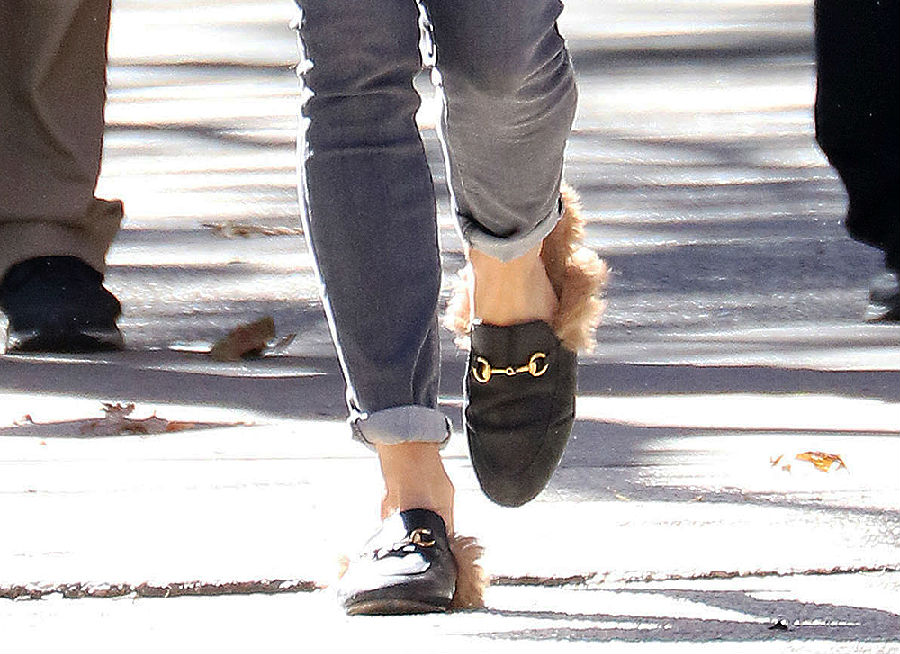In February 2015 Gucci unveiled this very furry shoe.
2015年2月,Gucci推出了这款毛茸茸的鞋子。
I love this ridiculous thing.
这玩意儿是深得我心啊。
I can’t afford to spend $1000, but no problem! I can buy this knockoff. Or this one.
虽然这鞋子1000美元一双我买不起,不过没关系!我可以买这款,或者这款山寨的。
So, which of these are legal? Trick question. They all are.
那……这些鞋子中哪一款才是合法的呢?这个问题有点儿伤脑筋啊。答案是,它们都是合法的。
And it’s a constant fight in the fashion industry.
这也是时尚圈一个一直以来都争论不休的问题。
In the US, you can protect songs. “I like those Balenciaga's, the ones that look...”
在美国,你可以保护歌曲。“我喜欢巴黎世家,那些看起来......”
Movies. “That blue represents millions of dollars and countless jobs…”
保护电影。 “就你那件蓝毛衣,代表的却是数百万美元的产业和无数人的工作.”
Or paintings.
也可以保护画作。
Why not fashion designs?
时尚设计怎么就不能保护了?
“Knockoffs” mostly are not counterfeits.
通常情况下,“山寨产品”和假货是不能划等号的。
People tend to conflate them but they’re not the same.
人们总是会把这两种产品混为一谈,但它们其实是不一样的。
This is a counterfeit.
这个包包是假货。
It copies the symbols of the brand that made the original.
它仿了原创品牌的细节标志。
So counterfeits are typically illegal.
假货通常是违法的。
Knockoffs, on the other hand, just resemble the design of the original.
而山寨只是和原创设计有那么一些相像。
And that’s usually fine. That’s because intellectual property laws only protect some kinds of designs.
这点通常都是没问题的。因为知识产权保护法保护的只是某些类型的设计。
A trademark is any symbol that indicates to consumers the source of products or services.
商标是任何能够向消费者传达产品或服务来源的标志。
This medallion on the front, which is the Tory Burch logo, tells you where the flat comes from. It comes from Tory Burch.
这款鞋子鞋面儿上的这个徽章,即汤丽柏琦的标志,就告诉你了这款平底鞋的来源,它是汤家的鞋子。

A patent is different.
专利就不一样了。
A useful and novel invention.
专利保护的是一项有用而新颖的发明。
They don’t work for most fashion designers because you can’t get damages until it’s granted
时尚设计师们通常是无法申请到专利的,因为专利只有申请成功之后才能拿到赔偿,
and by the time it's granted most fashions are out of fashion.
并且即便是专利拿下来了,那个时候大部分时装都已经过时了。
In fashion, the main battleground is Copyright.
时尚界争夺最厉害的是版权。
That is the right exclusively to copy or to distribute an artistic or literary work that is original.
也就是独家复制或分配一件原创艺术作品或文学作品的权利。
Like… “You’re wearing a sweater that was selected for you by the people in this room.”
比如......“你穿的毛衣是这个房间里的人为你挑选的。”
But not...
但下面这种就不算了...
The shape of this shoe is not copyrightable.
鞋子的形状是专利保护不到的。
Fashion designs are typically thought of as useful articles.
通常,人们都会把鞋子当做有用的物品。
Copyright doesn't protect useful things. It only protects artistic or literary things.
而版权保护的并不是有用的东西,它保护的是艺术作品或文学作品。
Unlike a song or a movie, a shoe or a T-shirt has utility as much as design.
与歌曲或电影不同,鞋子或T恤的实用性和设计感一样重要。
But… what about this? Not my thing?
可是......这个呢?不是我的菜是不是?
This might seem at a certain level to be kind of bizarre.
从某种程度上来讲,这个衣服有点儿奇怪。
But there is nonetheless a useful aspect to the garment. It does possibly keep you warm. Wait!
但这件衣服也还是有它实用的一面。比如,它或许可以御寒。等一下!
Tada! It’s art! Sort of.
塔哒!是不是很艺术!多少有点儿吧。
And now…It’s a gown.
现在......它已经变成一件礼服了。
You have copyright on the painting.
这幅画你是有版权的。
I can certainly have a copyright on the fabric design.
我们当然可以申请面料设计的版权。
I can't have a copyright on the shape of the dress.
但我们不能申请这个裙子的造型的版权。
The Subcommittee on Intellectual Property Competition, and the Internet will come to order the truth, the whole truth, and nothing but the truth, so help you God.
知识产权竞争小组委员会希望大家说出真相,说出所有真相,并只说真相,以便得到上帝保佑。
Fashion design is intellectual property that deserves protection.
时装设计是值得保护的知识产权。
We create something from nothing at all.
我们的创作都是从零开始的。
And in’t that the American dream?
美国梦难道不就是这样的吗?
I don’t agree with you.
我不同意你的看法。
But you’re very impressive in your testimony.
但你的证词给我留下了深刻的印象。
They say, well, we're artists and we deserve protection.
他们说,我们是艺术家,我们应该得到保护。
The answer to that argument is at least in the States we don't tend to make decisions about intellectual property based on what people deserve.
对此,我们的答案是,在美国,至少一般我们是不会因为大家值得被保护就决定颁布知识产权的。
We tend to make decisions based on what we think is healthy for creativity.
我们一般会根据是否有利于创新来决定要不要颁布的。
The Constitution does give Congress the right to stop copying, but only to “promote the progress” of creative industries.
宪法确实赋予了国会消灭抄袭的权利,但前提是能“促进创意产业的进步”。
When you look at countries across the world,
看看世界各国的情况,
you’ll see that there’s a correlation between the strength of intellectual property laws and higher GDP.
你就会发现知识产权法的效力和高GDP之间存在一定的相关性。
But in fashion, Sprigman believes that it’s actually the ability to copy that promotes progress.
但在时尚界,斯普里格曼认为,真正促进行业发展的实际上恰好是抄袭的能力。
Fashion designers take "inspiration", as they put it, from existing designs and they do this with abandon.
时装设计师,用他们自己的话说,是从现有的设计中汲取了灵感,但他们是有取有舍的。
But this is what creates trends, and trends sell fashion.
而潮流恰好就是这么来的,潮流反过来又推动了时尚。
When the copying proceeds to a certain point, fashion forward people have had enough. They jump off.
当抄袭达到一定程度,时尚达人们就会失去兴趣。他们就会将目光转向别处。
They jump on to the new trend that copying has helped to set.
转向抄袭推动起来的新潮流。
This rapid cycle, created by the freedom to copy, actually forces the fashion industry to innovate.
在抄袭自由催生的这种快速的时尚轮回下,时尚圈也不得不不断地创新。
If you look at the prices of fashion goods over time, what you see is that that top ten percent of fashion goods in terms of price,
看看时装商品的价格,你会看到价格最昂贵的那10%的时尚商品,
the price of these is going up and up and up over time.
它们的价格是随着时间不断上涨的。
Whereas everything else, those prices are staying stable or maybe falling a little bit over time.
而其他价位的时尚产品的价格则维持稳定,甚至可能稍有下降。
It doesn't seem like competition from knockoffs is disciplining the price of the luxury stuff.
表面来看,好像来自山寨品牌的竞争并没有影响到奢侈品牌的价格。
What seems to be happening in the fashion industry is what's happening in America and indeed in the world.
时尚圈正经历的事情也是整个美国,甚至全世界都在经历的事情:
The rich are getting richer disproportionately, and the clothes they wear as a result are getting much more expensive.
有钱人富得越来越离谱,他们穿的衣服也变得越来越昂贵。
The people who make those clothes, the companies that make those clothes, are profiting.
而盈利的是那些为他们制作衣服的人,公司。
New technology and the speed of production has amplified the two views on knockoffs.
新技术和生产速度放大了人们对山寨产品的两种看法。
Today, digital images from runway shows in New York can be uploaded to the Internet within minutes, and be copied,
今天,来自纽约时装秀的影像分分钟就能被人传到网上,被抄袭,
and offered for sale online within days, which is months before the designer is able to deliver the original garments to stores.
不日同款也会出现在网上,等设计师们要将那些时装上到店铺的货架上网上的同款都已经出来好几个月了。
That practice was not handed to us by God or by law.
这种做法并不是上帝传授给我们的,也不是法律规定的。
If the industry at the high end was very concerned about the speed of imitation, that practice would change. It isn’t.
如果高端时尚界很在意模仿的速度,那人们也会收敛一些。但事实并非如此。
So it’s hard to protect fashion designs because it’s not obvious that protecting them promotes progress.
总而言之,保护时尚设计很难,因为这么做并不能明显地推动行业的发展。
And from a legal perspective, that’s all that matters.
而从法律的角度来讲,最重要的恰好又是行业的发展。
Even though to the artists, that’s not the only thing at stake.
尽管对艺术家们来说,这并不是唯一紧要的东西。












